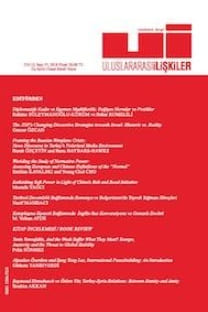Stepte ve Erken Dönem Avrupa’sında Devlet Oluşumu
It is not a self-evident thing for a group of scholars to invite an outsider who has studied the home turf of that group to open one of their conferences. I am extremely pleased to be here, and I want to make the most of the opportunity by calling attention to an area of study that my previous work has been pointing me to, and that I believe we who study International Relations (IR) should make our own. I am talking about a relation between two places in time. ! e relation is the one between nomads and sedentaries. The places are the Eurasian steppe and the sedentary polities to its west. By the Eurasia steppe I mean that vast tract of land that stretched from the Mongolian-Turkic homelands around Karakorum, north of the agricultural lands of the Chinese, the Persians and the Byzantines, all the way to where the grasslands started to give way to forest, and where there lived Slavic and Finno-Ugric tribes. The time is what Europeans call the middle ages.
The Steppe and Early European State Formation
It is not a self-evident thing for a group of scholars to invite an outsider who has studied the home turf of that group to open one of their conferences. I am extremely pleased to be here, and I want to make the most of the opportunity by calling attention to an area of study that my previous work has been pointing me to, and that I believe we who study International Relations (IR) should make our own. I am talking about a relation between two places in time. ! e relation is the one between nomads and sedentaries. The places are the Eurasian steppe and the sedentary polities to its west. By the Eurasia steppe I mean that vast tract of land that stretched from the Mongolian-Turkic homelands around Karakorum, north of the agricultural lands of the Chinese, the Persians and the Byzantines, all the way to where the grasslands started to give way to forest, and where there lived Slavic and Finno-Ugric tribes. The time is what Europeans call the middle ages.
___
- .....
- ISSN: 1304-7310
- Başlangıç: 2004
- Yayıncı: Uluslararası İlişkiler Konseyi Derneği İktisadi İşletmesi
Sayıdaki Diğer Makaleler
Uluslararası Çevre Rejimlerinde Etkinlik Sorunu
Stepte ve Erken Dönem Avrupa’sında Devlet Oluşumu
H. Tolga BÖLÜKBAŞI, Ebru ERTUGAL, Saime ÖZÇÜRÜMEZ
Uluslararası İş Birliğini Yeniden Düşünmek: Rekabet Politikasında Düzenleyici Ağlar Örneği
Algı mı, Söylem mi? Kopenhag Okulu ve Yeni Klasik Gerçekçilikte Güvenlik Tehditleri
“Uluslararası” Fikri, Epistemolojik Yanılgı ve Eleştirel Gerçekliğin İmkânları
